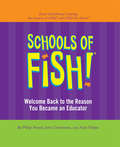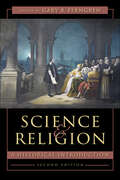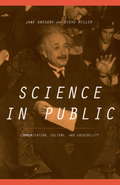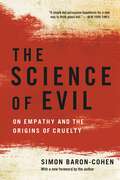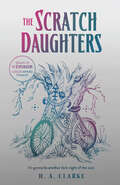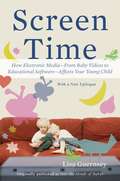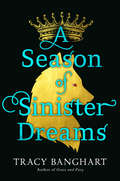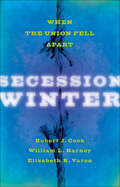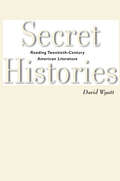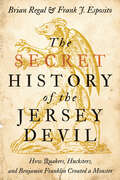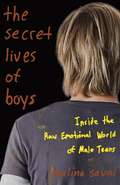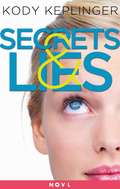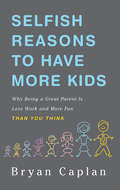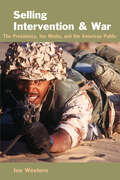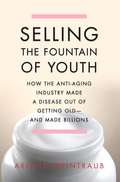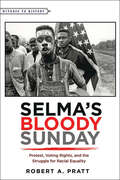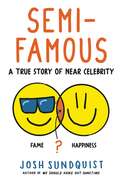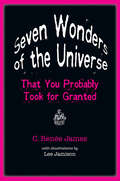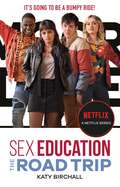- Table View
- List View
Schools of Fish!
by Philip Strand John Christensen Andy HalperIt's two minutes to 8:00. Time to put on your tights and cape. As an educator, every time that bell rings, you face dozens of challenges. Students with overwhelming personal and academic needs. Creativity-stifling mandates. Administrivia. Cynicism. Apathy. The things that keep you from being the educator you want to be. The FISH! Philosophy--four simple principles: Be There, Play, Make Their Day, and Choose Your Attitude--has helped educators around the world build more effective, fulfilling relationships that lead to better learning. It is also backed by tons (OK, about a hundred pounds) of research on classroom management. Schools of FISH! is full of inspiring and instructive stories about people just like you--with hopes and challenges just like yours. It's about real-life heroes who give the best in themselves to help their students find the best in themselves. Schools of FISH! offers practical ideas on classroom management. It addresses the issues you deal with every day--improving learning, respect and personal accountability, self-discipline and internal motivation, and finding ways to make learning more fun. Because you're not just teaching students to learn . . . you're inspiring them to want to learn.
Schools of Fish!
by Philip Strand John Christensen Andy HalperIt's two minutes to 8:00. Time to put on your tights and cape. As an educator, every time that bell rings, you face dozens of challenges. Students with overwhelming personal and academic needs. Creativity-stifling mandates. Administrivia. Cynicism. Apathy. The things that keep you from being the educator you want to be. The FISH! Philosophy--four simple principles: Be There, Play, Make Their Day, and Choose Your Attitude--has helped educators around the world build more effective, fulfilling relationships that lead to better learning. It is also backed by tons (OK, about a hundred pounds) of research on classroom management. Schools of FISH! is full of inspiring and instructive stories about people just like you--with hopes and challenges just like yours. It's about real-life heroes who give the best in themselves to help their students find the best in themselves.Schools of FISH! offers practical ideas on classroom management. It addresses the issues you deal with every day--improving learning, respect and personal accountability, self-discipline and internal motivation, and finding ways to make learning more fun. Because you're not just teaching students to learn . . . you're inspiring them to want to learn.
Science and Religion: A Historical Introduction
by Gary B. FerngrenSince its publication in 2002, Science and Religion has proven to be a widely admired survey of the complex relationship of Western religious traditions to science from the beginning of the Christian era to the late twentieth century. In the second edition, eleven new essays expand the scope and enhance the analysis of this enduringly popular book.Tracing the rise of science from its birth in the medieval West through the scientific revolution, the contributors here assess historical changes in scientific understanding brought about by transformations in physics, anthropology, and the neurosciences and major shifts marked by the discoveries of Copernicus, Galileo, Isaac Newton, Charles Darwin, and others. In seeking to appreciate the intersection of scientific discovery and the responses of religious groups, contributors also explore the theological implications of contemporary science and evaluate approaches such as the Bible in science and the modern synthesis in evolution, which are at the center of debates in the historiography, understanding, and application of science.The second edition provides chapters that have been revised to reflect current scholarship along with new chapters that bring fresh perspectives on a diverse range of topics, including new scientific approaches and disciplines and non-Christian traditions such as Judaism, Islam, Asiatic religions, and atheism. This indispensible classroom guide is now more useful than ever before.Contributors: Richard J. Blackwell, Peter J. Bowler, John Hedley Brooke, Glen M. Cooper, Edward B. Davis, Alnoor Dhanani, Diarmid A. Finnegan, Noah Efron, Owen Gingerich, Edward Grant, Steven J. Harris, Matthew S. Hedstrom, John Henry, Peter M. Hess, Edward J. Larsen, Timothy Larson, David C. Lindberg, David N. Livingstone, Craig Martin, Craig Sean McConnell, James Moore, Joshua M. Moritz, Mark A. Noll, Ronald L. Numbers, Richard Olson, Christopher M. Rios, Nicolaas A. Rupke, Michael H. Shank, Stephen David Snobelen, John Stenhouse, Peter J. Susalla, Mariusz Tabaczek, Alan C. Weissenbacher, Stephen P. Weldon, and Tomoko Yoshida
Science and Religion: A Historical Introduction
by Gary B. FerngrenSince its publication in 2002, Science and Religion has proven to be a widely admired survey of the complex relationship of Western religious traditions to science from the beginning of the Christian era to the late twentieth century. In the second edition, eleven new essays expand the scope and enhance the analysis of this enduringly popular book.Tracing the rise of science from its birth in the medieval West through the scientific revolution, the contributors here assess historical changes in scientific understanding brought about by transformations in physics, anthropology, and the neurosciences and major shifts marked by the discoveries of Copernicus, Galileo, Isaac Newton, Charles Darwin, and others. In seeking to appreciate the intersection of scientific discovery and the responses of religious groups, contributors also explore the theological implications of contemporary science and evaluate approaches such as the Bible in science and the modern synthesis in evolution, which are at the center of debates in the historiography, understanding, and application of science.The second edition provides chapters that have been revised to reflect current scholarship along with new chapters that bring fresh perspectives on a diverse range of topics, including new scientific approaches and disciplines and non-Christian traditions such as Judaism, Islam, Asiatic religions, and atheism. This indispensible classroom guide is now more useful than ever before.Contributors: Richard J. Blackwell, Peter J. Bowler, John Hedley Brooke, Glen M. Cooper, Edward B. Davis, Alnoor Dhanani, Diarmid A. Finnegan, Noah Efron, Owen Gingerich, Edward Grant, Steven J. Harris, Matthew S. Hedstrom, John Henry, Peter M. Hess, Edward J. Larsen, Timothy Larson, David C. Lindberg, David N. Livingstone, Craig Martin, Craig Sean McConnell, James Moore, Joshua M. Moritz, Mark A. Noll, Ronald L. Numbers, Richard Olson, Christopher M. Rios, Nicolaas A. Rupke, Michael H. Shank, Stephen David Snobelen, John Stenhouse, Peter J. Susalla, Mariusz Tabaczek, Alan C. Weissenbacher, Stephen P. Weldon, and Tomoko Yoshida
Science In Public: Communication, Culture, And Credibility
by Jane Gregory Steven MillerDoes the general public need to understand science? And if so, is it scientists' responsibility to communicate? Critics have argued that, despite the huge strides made in technology, we live in a "scientifically illiterate" society--one that thinks about the world and makes important decisions without taking scientific knowledge into account. But is the solution to this "illiteracy" to deluge the layman with scientific information? Or does science news need to be focused around specific issues and organized into stories that are meaningful and relevant to people's lives? In this unprecedented, comprehensive look at a new field, Jane Gregory and Steve Miller point the way to a more effective public understanding of science in the years ahead.
The Science of Evil: On Empathy and the Origins of Cruelty
by Simon Baron-CohenA groundbreaking and challenging examination of the social, cognitive, neurological, and biological roots of psychopathy, cruelty, and evilBorderline personality disorder, autism, narcissism, psychosis: All of these syndromes have one thing in common--lack of empathy. In some cases, this absence can be dangerous, but in others it can simply mean a different way of seeing the world.In The Science of Evil Simon Baron-Cohen, an award-winning British researcher who has investigated psychology and autism for decades, develops a new brain-based theory of human cruelty. A true psychologist, however, he examines social and environmental factors that can erode empathy, including neglect and abuse.Based largely on Baron-Cohen's own research, The Science of Evil will change the way we understand and treat human cruelty.
The Scratch Daughters
by H.A. ClarkeThe second book in the Scapegracers trilogy, formerly outcast lesbian witch who struggles to keep her coven as the loss of her magical soul drives her to desperation.
Screen Time: How Electronic Media-From Baby Videos to Educational Software-Affects Your Young Child
by Lisa GuernseyAs a mother, Lisa Guernsey wondered about the influence of television on her two young daughters. As a reporter, she resolved to find out. What she first encountered was tired advice, sensationalized research claims, and a rather draconian mandate from the American Academy of Pediatrics: no TV at all before the age of two. But like many parents, she wanted straight answers and realistic advice, so she kept digging: she visited infant-perception labs and child development centers around the country. She interviewed scores of parents, psychologists, cognitive scientists, and media researchers, as well as programming executives at Noggin, Disney, Nickelodeon, Sesame Workshop, and PBS. Much of what she found flies in the face of conventional wisdom and led her to conclude that new parents will be best served by focusing on &“the three C&’s&”: content, context, and the individual child. Advocating a new approach to television and DVDs, Guernsey focuses on infants to five-year-olds and goes beyond the headlines to explore what exactly is &“educational&” about educational media. She examines how play and language development are affected by background and foreground television and how to choose videos that are age-appropriate. She explains how to avoid the hype of &“brain stimulation&” and focus instead on social relationships and the building blocks of language and literacy. Along the way, Guernsey highlights independent research on shows ranging from Dora the Explorer to Dragon Tales, and distills some surprising new findings in the field of child development. Into the Minds of Babes is a fascinating book that points out how little credible research exists to support the AAP&’s dire recommendation. Parents, teachers, and psychologists will be relieved to learn positive approaches to using videos with young children and will be empowered to make their own informed choices.
A Season of Sinister Dreams
by Tracy BanghartFuryborn meets A Curse So Dark and Lonely in this thrilling fantasy about two powerful girls coming together to protect their beloved kingdom—from the author of Grace and Fury. Annalise may be cousin to the prince, but her past isn't what she claims, and she possesses a magic so powerful it takes all her strength to control it. Evra is a country girl, and has watched as each friend and family member came into their own magic, while hers remains dormant. But everything changes after Annalise loses control of herself and Evra begins experiencing the debilitating visions of a once-in-a-generation clairvoyant meant to serve the crown. Thrown together at court, Evra and Annalise find that they have the same goal: to protect their kingdom from the powerful men who are slowly destroying it. But neither is quick to trust the other—Evra's visions suggest a threat to royal rule, and Annalise worries that her darkest secrets will be revealed. Their magic at odds, the young women circle each other, until the truth must come out. Full of intrigue, romance, and shocking twists, this gorgeously immersive fantasy will keep readers spellbound until the very last page.
Secession Winter: When the Union Fell Apart (The Marcus Cunliffe Lecture Series)
by William L. Barney Robert J. Cook Elizabeth R. VaronPoliticians and opinion leaders on both sides of the Mason-Dixon line struggled to formulate coherent responses to the secession of the deep South states. The Confederate attack on Fort Sumter in mid-April 1861 triggered civil war and the loss of four upper South states from the Union. The essays by three senior historians in Secession Winter explore the robust debates that preceded these events.For five months in the winter of 1860–1861, Americans did not know for certain that civil war was upon them. Some hoped for a compromise; others wanted a fight. Many struggled to understand what was happening to their country. Robert J. Cook, William L. Barney, and Elizabeth R. Varon take approaches to this period that combine political, economic, and social-cultural lines of analysis. Rather than focus on whether civil war was inevitable, they look at the political process of secession and find multiple internal divisions—political parties, whites and nonwhites, elites and masses, men and women. Even individual northerners and southerners suffered inner conflicts. The authors include the voices of Unionists and Whig party moderates who had much to lose and upcountry folk who owned no slaves and did not particularly like those who did. Barney contends that white southerners were driven to secede by anxiety and guilt over slavery. Varon takes a new look at Robert E. Lee's decision to join the Confederacy. Cook argues that both northern and southern politicians claimed the rightness of their cause by constructing selective narratives of historical grievances. Secession Winter explores the fact of contingency and reminds readers and students that nothing was foreordained.
Secret Histories: Reading Twentieth-Century American Literature
by David WyattSecret Histories claims that the history of the nation is hidden—in plain sight—within the pages of twentieth-century American literature. David Wyatt argues that the nation's fiction and nonfiction expose a "secret history" that cuts beneath the "straight histories" of our official accounts. And it does so by revealing personal stories of love, work, family, war, and interracial romance as they were lived out across the decades of the twentieth century. Wyatt reads authors both familiar and neglected, examining "double consciousness" in the post–Civil War era through works by Charles W. Chesnutt, W. E. B. Du Bois, and Booker T. Washington. He reveals aspects of the Depression in the fiction of F. Scott Fitzgerald, Anzia Yezierska, and John Steinbeck. Period by period, Wyatt's nuanced readings recover the felt sense of life as it was lived, opening surprising dimensions of the critical issues of a given time. The rise of the women's movement, for example, is revivified in new appraisals of works by Eudora Welty, Ann Petry, and Mary McCarthy.Running through the examination of individual works and times is Wyatt's argument about reading itself. Reading is not a passive activity but an empathetic act of cocreation, what Faulkner calls "overpassing to love." Empathetic reading recognizes and relives the emotional, cultural, and political dimensions of an individual and collective past. And discovering a usable American past, as Wyatt shows, enables us to confront the urgencies of our present moment.
The Secret History of the Jersey Devil: How Quakers, Hucksters, and Benjamin Franklin Created a Monster
by Brian Regal Frank J. EspositoLegend has it that in 1735 a witch named Mother Leeds gave birth to a horrifying monster;¢;‚¬;€?a deformed flying horse with glowing red eyes;¢;‚¬;€?that flew up the chimney of her New Jersey home and disappeared into the Pine Barrens. Ever since, this nightmarish beast has haunted those woods, presaging catastrophe and frightening innocent passersby;¢;‚¬;€?or so the story goes. In The Secret History of the Jersey Devil, Brian Regal and Frank J. Esposito examine the genesis of this popular myth, which is one of the oldest monster legends in the United States.According to Regal and Esposito, everything you think you know about the Jersey Devil is wrong. The real story of the Jersey Devil's birth is far more interesting, complex, and important than most people;¢;‚¬;€?believers and skeptics alike;¢;‚¬;€?realize. Leaving the Pine Barrens, Regal and Esposito turn instead to the varied political and cultural roots of the Devil's creation. Fascinating and lively, this book finds the origins of New Jersey's favorite monster not in witchcraft or an unnatural liaison between woman and devil but in the bare-knuckled political fights and religious upheavals of colonial America. A product of innuendo and rumor, as well as scandal and media hype, the Jersey Devil enjoys a rich history involving land grabs, astrological predictions, mermaids and dinosaur bones, sideshows, Napoleon Bonaparte's brother, a cross-dressing royal governor, and Founding Father Benjamin Franklin.
The Secret History of the Jersey Devil: How Quakers, Hucksters, and Benjamin Franklin Created a Monster
by Brian Regal Frank J. EspositoLegend has it that in 1735 a witch named Mother Leeds gave birth to a horrifying monster;¢;‚¬;€?a deformed flying horse with glowing red eyes;¢;‚¬;€?that flew up the chimney of her New Jersey home and disappeared into the Pine Barrens. Ever since, this nightmarish beast has haunted those woods, presaging catastrophe and frightening innocent passersby;¢;‚¬;€?or so the story goes. In The Secret History of the Jersey Devil, Brian Regal and Frank J. Esposito examine the genesis of this popular myth, which is one of the oldest monster legends in the United States.According to Regal and Esposito, everything you think you know about the Jersey Devil is wrong. The real story of the Jersey Devil's birth is far more interesting, complex, and important than most people;¢;‚¬;€?believers and skeptics alike;¢;‚¬;€?realize. Leaving the Pine Barrens, Regal and Esposito turn instead to the varied political and cultural roots of the Devil's creation. Fascinating and lively, this book finds the origins of New Jersey's favorite monster not in witchcraft or an unnatural liaison between woman and devil but in the bare-knuckled political fights and religious upheavals of colonial America. A product of innuendo and rumor, as well as scandal and media hype, the Jersey Devil enjoys a rich history involving land grabs, astrological predictions, mermaids and dinosaur bones, sideshows, Napoleon Bonaparte's brother, a cross-dressing royal governor, and Founding Father Benjamin Franklin.
The Secret Lives of Boys: Inside the Raw Emotional World of Male Teens
by Malina SavalTeenage boys have come a long way since the staid 1980s when they were all lumped into the Breakfast Club categories of Brains, Druggies, and Jocks. Crisscrossing the country-meeting with boys from different cultures, and socioeconomic backgrounds-journalist Malina Saval introduces readers to the next generation of male teens by creating new archetypes and redrawing the ever-expanding social map. The Secret Lives of Boys offers an uncensored look into boyhood that reveals the spine-tingling confessions, heartrending sadness and isolation, unbridled optimism, and seemingly boundless resilience of male teens today. Saval asks the pertinent questions: Who are these boys? What do they think of themselves? A compelling and candid look at male adolescence in the twenty-first century, The Secret Lives of Boys uncovers what our young people want you to know.
The Secret Side of Empty
by Maria E. AndreuA 2014 National Indie Excellence Award winnerA Junior Library Guild Selection, 2014A School Library Journal Top 10 Latino Books of 2014As a straight-A student with a budding romance and loyal best friend, M.T.'s life seems as apple-pie American as her blondish hair and pale skin. But M.T. hides two facts to the contrary: her full name of Monserrat Thalia and her status as an undocumented immigrant.With senior year of high school kicking into full swing, M.T. sees her hopes for a "normal” future unraveling. And it will take discovering a sense of trust in herself and others for M.T. to stake a claim in the life that she wants.Author Maria E. Andreu draws from her personal experience to tell a story that is timely, relevant, and universally poignant.
Secrets & Lies: Two Short Stories
by Kody KeplingerKody Keplinger both returns to the halls of Hamilton High and explores new territory in her collection of two e-book exclusive novellas. In these short stories, the author revisits a familiar cast of characters from THE DUFF (Designated Ugly Fat Friend) and A Midsummer's Nightmare. Explore the uniquely teen world of high school drama, secrets, and romantic entanglements from completely fresh perspectives that will intrigue fans of Kody Keplinger and new readers alike.
Selfish Reasons to Have More Kids: Why Being a Great Parent is Less Work and More Fun Than You Think
by Bryan CaplanWe've needlessly turned parenting into an unpleasant chore. Parents invest more time and money in their kids than ever, but the shocking lesson of twin and adoption research is that upbringing is much less important than genetics in the long run. These revelations have surprising implications for how we parent and how we spend time with our kids. The big lesson: Mold your kids less and enjoy your life more. Your kids will still turn out fine.Selfish Reasons to Have More Kids is a book of practical big ideas. How can parents be happier? What can they change--and what do they need to just accept? Which of their worries can parents safely forget? Above all, what is the right number of kids for you to have? You'll never see kids or parenthood the same way again.
Selling Intervention and War: The Presidency, the Media, and the American Public
by Jon WesternSelling Intervention and War examines the competition among foreign policy elites in the executive branch and Congress in winning the hearts and minds of the American public for military intervention. The book studies how the president and his supporters organize campaigns for public support for military action. According to Jon Western, the outcome depends upon information and propaganda advantages, media support or opposition, the degree of cohesion within the executive branch, and the duration of the crisis. Also important is whether the American public believes that military threat is credible and victory plausible. Not all such campaigns to win public support are successful; in some instances, foreign policy elites and the president and his advisors have to back off. Western uses several modern conflicts, including the current one in Iraq, as case studies to illustrate the methods involved in selling intervention and war to the American public: the decision not to intervene in French Indochina in 1954, the choice to go into Lebanon in 1958, and the more recent military actions in Grenada, Somalia, Bosnia, and Iraq. Selling Intervention and War is essential reading for scholars and students of U.S. foreign policy, international security, the military and foreign policy, and international conflict.
Selling Intervention and War: The Presidency, the Media, and the American Public
by Jon WesternSelling Intervention and War examines the competition among foreign policy elites in the executive branch and Congress in winning the hearts and minds of the American public for military intervention. The book studies how the president and his supporters organize campaigns for public support for military action. According to Jon Western, the outcome depends upon information and propaganda advantages, media support or opposition, the degree of cohesion within the executive branch, and the duration of the crisis. Also important is whether the American public believes that military threat is credible and victory plausible. Not all such campaigns to win public support are successful; in some instances, foreign policy elites and the president and his advisors have to back off. Western uses several modern conflicts, including the current one in Iraq, as case studies to illustrate the methods involved in selling intervention and war to the American public: the decision not to intervene in French Indochina in 1954, the choice to go into Lebanon in 1958, and the more recent military actions in Grenada, Somalia, Bosnia, and Iraq. Selling Intervention and War is essential reading for scholars and students of U.S. foreign policy, international security, the military and foreign policy, and international conflict.
Selling the Fountain of Youth: How the Anti-Aging Industry Made a Disease Out of Getting Old-And Made Billions
by Arlene WeintraubThe beauty industry—which once revolved around creams and powders, subtle agents to enhance beauty—has become the anti-aging industry, overrun with steroids, human growth hormone injections, and &“bio-identical&” hormones—all promoted as &“cures&” for getting old. Acclaimed BusinessWeek science reporter Arlene Weintraub takes us inside this world, from the marketing departments of huge pharmaceutical companies to the backroom of your local pharmacy, from celebrity enthusiasts like Suzanne Somers and Oprah to the self-medicating doctors who run chains of rejuvenation centers, all claiming that we deserve to be forever young—and promising to show us how.Weintraub reveals the shady practices that run rampant when junk science and dubious marketing meet consumer choice. She shows for the remarkable economic and cultural impact of anti-aging medicine, on the patients who partake and on the rest of us. It&’s not a pretty story, but Weintraub tells us everything we need to know to avoid being duped by this billion-dollar—and dangerous—hoax.
Selma;€™s Bloody Sunday: Protest, Voting Rights, and the Struggle for Racial Equality (Witness to History)
by Robert A. PrattOn Sunday afternoon, March 7, 1965, roughly six hundred peaceful demonstrators set out from Brown Chapel A.M.E. Church in a double-file column to march from Selma, Alabama, to the state capital of Montgomery. Leading the march were Hosea Williams of the Southern Christian Leadership Conference and John Lewis of the Student Nonviolent Coordinating Committee. Upon reaching Broad Street, the marchers turned left to cross the Edmund Pettus Bridge that spanned the Alabama River. "When we reached the crest of the bridge," recalls John Lewis, "I stopped dead still. So did Hosea. There, facing us at the bottom of the other side, stood a sea of blue-helmeted, blue-uniformed Alabama state troopers, line after line of them, dozens of battle-ready lawmen stretched from one side of U.S. Highway 80 to the other. Behind them were several dozen more armed men;¢;‚¬;€?Sheriff Clark;€™s posse;¢;‚¬;€?some on horseback, all wearing khaki clothing, many carrying clubs the size of baseball bats."The violence and horror that was about to unfold at the foot of the bridge would forever mark the day as "Bloody Sunday," one of the pivotal moments of the civil rights movement. Alabama state troopers fell on the unarmed protestors as they crossed the bridge, beating and tear gassing them. In Selma;€™s Bloody Sunday, Robert A. Pratt offers a vivid account of that infamous day and the indelible triumph of black and white protest over white resistance. He explores how the march itself;¢;‚¬;€?and the 1965 Voting Rights Act that followed;¢;‚¬;€?represented a reaffirmation of the nation;€™s centuries-old declaration of universal equality and the fulfillment of the Fifteenth Amendment to the Constitution.Selma;€™s Bloody Sunday offers a fresh interpretation of the ongoing struggle by African Americans to participate freely in America;€™s electoral democracy. Jumping forward to the present day, Pratt uses the march as a lens through which to examine disturbing recent debates concerning who should, and who should not, be allowed to vote. Drawing on archival materials, secondary sources, and eyewitness accounts of the brave men and women who marched, this gripping account offers a brief and nuanced narrative of this critical phase of the black freedom struggle.
Selma;€™s Bloody Sunday: Protest, Voting Rights, and the Struggle for Racial Equality (Witness to History)
by Robert A. PrattOn Sunday afternoon, March 7, 1965, roughly six hundred peaceful demonstrators set out from Brown Chapel A.M.E. Church in a double-file column to march from Selma, Alabama, to the state capital of Montgomery. Leading the march were Hosea Williams of the Southern Christian Leadership Conference and John Lewis of the Student Nonviolent Coordinating Committee. Upon reaching Broad Street, the marchers turned left to cross the Edmund Pettus Bridge that spanned the Alabama River. "When we reached the crest of the bridge," recalls John Lewis, "I stopped dead still. So did Hosea. There, facing us at the bottom of the other side, stood a sea of blue-helmeted, blue-uniformed Alabama state troopers, line after line of them, dozens of battle-ready lawmen stretched from one side of U.S. Highway 80 to the other. Behind them were several dozen more armed men;¢;‚¬;€?Sheriff Clark;€™s posse;¢;‚¬;€?some on horseback, all wearing khaki clothing, many carrying clubs the size of baseball bats."The violence and horror that was about to unfold at the foot of the bridge would forever mark the day as "Bloody Sunday," one of the pivotal moments of the civil rights movement. Alabama state troopers fell on the unarmed protestors as they crossed the bridge, beating and tear gassing them. In Selma;€™s Bloody Sunday, Robert A. Pratt offers a vivid account of that infamous day and the indelible triumph of black and white protest over white resistance. He explores how the march itself;¢;‚¬;€?and the 1965 Voting Rights Act that followed;¢;‚¬;€?represented a reaffirmation of the nation;€™s centuries-old declaration of universal equality and the fulfillment of the Fifteenth Amendment to the Constitution.Selma;€™s Bloody Sunday offers a fresh interpretation of the ongoing struggle by African Americans to participate freely in America;€™s electoral democracy. Jumping forward to the present day, Pratt uses the march as a lens through which to examine disturbing recent debates concerning who should, and who should not, be allowed to vote. Drawing on archival materials, secondary sources, and eyewitness accounts of the brave men and women who marched, this gripping account offers a brief and nuanced narrative of this critical phase of the black freedom struggle.
Semi-Famous: A True Story of Near Celebrity
by Josh SundquistIn this "laugh-out-loud funny&” book (Hank Green, New York Times bestselling author), social media star and comedian Josh Sundquist takes readers on his hilarious journey to the fringes of viral stardom to discover if it&’s possible to be both very famous and very happy As a semi-famous internet creator, Josh Sundquist knows what it's like to chase fame, but he also knows that more fame usually means more stress. So he set out on a pseudo-scientific investigation to find out if there is any way for fame and happiness to overlap. He attempts to define the word &“fame&”—hint: it's harder than you'd think. He turns back time to identify the first facially-recognizable celebrity (you might know his former BFF Brutus). He digs into the numbers to debunk urban legends associated with stardom (ever heard of the 27 Club?). He talks to other semi-famous people (from K-pop sensations to former child stars) and asks them: Is this fame thing making you happy? If not, why are you doing it? If so, what's your secret? All while recounting funny stories about his own cringy fame-seeking (like his many attempts, and failures, to get onto MTV). Packed with playful diagrams, fascinating insights from celebrities, and embarrassing truths from Josh&’s experience with semi-fame, this is a must-read for anyone who has ever dreamed of becoming famous…or at least going viral on TikTok.
Seven Wonders of the Universe That You Probably Took for Granted
by C. Renée JamesTime. Gravity. Night. So much of what surrounds us feels familiar and mundane. But each is a wonder that reveals profound insights into the world around us.C. Renée James's whimsical tour of seven everyday experiences—night, light, stuff, gravity, time, home, and wonder—opens the Universe to fantastical contemplation. Light? Although we need it to see, there's much more to it than meets the eye. Stuff? When it comes down to it, things are almost entirely empty space—99.9% nothing—especially when you get to the atomic level. Home? James's contemplation of our place in the Universe shows that it's not just a place to hang your hat—and that there’s really nothing else like it. James introduces each of these seven wonders with a simple question that appears to be easily answered. The questions are deceptive, though—as is James's casual, light-hearted style. Underneath lie such concepts as relativity, matter and antimatter, and the electromagnetic spectrum. Her accessible discussion uses common analogies and entertaining illustrations to provide a bundle of detail on historical discoveries and to provoke serious pondering. Fun and edifying, Seven Wonders of the Universe That You Probably Took for Granted is an inviting introduction to secret knowledge of our everyday world. This book may be 99.9% nothing, but the thoughts it will inspire are massive.
Sex Education: The Road Trip
by Katy BirchallThe only official Sex Education novel. When the screen binge is over, return to the world of Moordale with a brand-new story featuring the show's most popular characters.Maeve gets an unexpected call from her brother Sean. It's no surprise to her that he is in trouble again. But she's the only family he's got, so she must saddle up and ride to the rescue. Or at least, scrounge a lift from Aimee and drive there. . . . Otis and Eric insist they can help, and Maeve's mission becomes a summer holiday road trip. Sean's been partying with a group of decadent rich kids who have no accused him of a crime. The evidence against him is pretty damning. Trying to clear his name, Maeve and friends integrate themselves into the rich kids' circle--it's time to go undercover. Thanks to Eric's dance floor moves, Aimee's easy charm, and Otis's ability to offer good advice, they get to know the group. And they soon discover that Sean is not the only one with a motive for getting even with beautiful party girl Tabitha.This standalone YA/crossover story has everything fans love about the show: favorite characters with real emotional depth, no-holds-barred honesty about teenage relationships, brilliant humor, and a great new storyline, plus a compelling whodunit at its heart.
